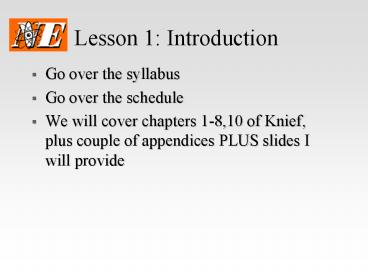Lesson 1: Introduction PowerPoint PPT Presentation
1 / 17
Title: Lesson 1: Introduction
1
Lesson 1 Introduction
- Go over the syllabus
- Go over the schedule
- We will cover chapters 1-8,10 of Knief, plus
couple of appendices PLUS slides I will provide
2
Introductory thoughts
- This is a PROFESSIONAL course
- How a particular corner of nuclear work does its
thing - Not so much theory as in other courses, but
pulling together theory from other disciplines to
get a job done - Goals
- Learn what criticality safety is and how it is
performed in the real world - Learn the terminology and be able to discuss it
rationally (Tests) - Learn how to run SCALE for criticality problems
- Learn about NCSEs What they are, how they are
made, experience in writing one - Get a head start on a Qual Card
3
Introductory thoughts (2)
- Related to reactor theory, but
- No burnup per se
- No transient study
- More diverse geometries
- MUCH higher dependence on neutron leakage
- Hot job and consulting market right now
- If you have experienceGetting in the door is not
quite as easy - Crit safety is a pretty small world
- Good basic background for going into related
areas Shielding, reactor apps.
4
Introductory thoughts (3)
- Oak Ridge is a center of activity X-10 for
methods, X-10/K-25/Y-12 for practice - My experience is at Savannah River, Rocky Flats,
Yucca Mountain, NFS (Erwin, TN), Portsmouth GDP,
USEC, Y-12 - Much of the course content will reflect this
- Controversy in field
- Black box code use vs. experimental and
handbook evaluations - Overall training standards ANSI/ANS 8.26
- The course occasionally has a pro or two in it
5
Course workload
- How you are evaluated
- Two tests on text material
- Report on easily found material
- Practice on a computational NCSE
- New this year 5 points for proving to me that
you got SCALE from RSICC (by Test1) - Good practical experience for resume
- Familiarity with a specialized vocabulary
- Knowledge of ANS standards
- SCALE
- NCSE (individual projects)
6
Goals and objectives
- Goals and objectives
- Goal of the textbook Need and implementation
- 7 particular objectives
- Define crit safety
- Explain significance of accident history
- Explain significance of Standards
- Explain significance of Benchmarks and Calcs
- Setting limits
- Hand calculational methods
- Role of orders and licenses (DOE/NRC)
- Unique devices and practices for crit safety
7
Special terms
- Nuclear criticality safety
- Fuel cycle facilities outside of nuclear
reactors - Criticality accidents
- Standard
- Benchmark experiment
- Subcritical limit
8
Special terms (contd)
- Nuclear chain reaction
- Fissile materials
- Radiation protection
- NRC
- DOE
9
Fundamental concepts
- Production without undue risk to the public or
environment as safety requirement - Basic safety requirements are based on identity,
mass, composition, and concentration of fissile
species and the presence of other materials
10
Definitions of Criticality Safety
- The prevention or termination of inadvertent
nuclear chain reactions in nonreactor
environments - The art of avoiding a criticality excursion
- Protection against the consequences of
11
NCS practice
- Integration of
- Neutron physics (reactor physics)
- Engineering design processes
- Human factorsBoth us and them (evaluators and
operators) - Historical trends
- Extreme conservatism
- Expanding production beyond safety philosophy
- Recognition of need for more formal approach
12
Paxtons Principles of Safety
- Risk vs. benefit. Neither ignore risk nor require
complete elimination. - Responsibility at lowest possible level. Do
nothing you do not feel safe doing. - Professional standards and flexibility.
- Simple rather than complex provisions. Physical
vs. operational vs. administrative.
13
Contact RSICC soon
- Go to RSICC website
- Registration and ordering
- New User
- Fill out form
- Organization type University
- Project typeCriticality safety
- Funding source 1 Univ. Nuclear Engineering 100
- Customer feedback I am a NE student at UT and
need SCALE and MCNP for Introduction to
Criticality course - Online/WWW ordering
- Get SCALE6.1/ORIGEN C00732
14
Criticality Neutron balance
- Critical configuration Neutron PRODUCTION from
fission exactly balances neutron LOSS from
absorption and leakage
15
Criticality Neutron balance (2)
- Our focus is a little different from reactor
physics because we are much more influenced by
LEAKAGE - In this regard, we are much closer to Fermi, et
al., because of the UNIQUENESS of our situations
and our strong dependence on SIZE and SHAPE of
the system being considered
16
U-235 Sphere
17
What if we fail?
- What stops a criticality accident once it starts?
- Temperature feedback (metals)
- Void formation (solutions)
- Material dispersion (solutions)
- Geometric rearrangement (metals and solutions)
- Big problem recriticality

